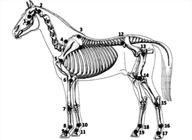| 01 |
Amplitude da passada anterior ao salto |
Comprimento da passada completa do membro torácico esquerdo anterior ao salto |
9 |
| 02 |
Velocidade da passada anterior ao salto |
Velocidade horizontal para percorrer a variável nº 01, calculada como a distância sobre tempo |
- |
| 03 |
Distância da batida |
Distância entre obstáculo e casco pélvico mais próximo ao obstáculo, imediatamente antes da fase de voo (decolagem) |
17 ou 19 |
| 04 |
Distância da recepção |
Distância entre o obstáculo e o casco torácico que toca primeiro o solo imediatamente após a fase de voo (aterrissagem) |
9 ou 11 |
| 05 |
Amplitude do salto
|
Mensurado pela distância entre o contato do casco pélvico esquerdo com o solo na batida até o contato deste mesmo casco com o solo na recepção (comprimento do salto) |
17 |
| 06 |
Velocidade do salto |
Velocidade horizontal da variável nº 05, calculada como a distância sobre tempo |
- |
| 07 |
Altura dos membros torácicos no salto |
Altura mínima dos membros torácicos no momento da passagem sobre o segundo elemento do obstáculo |
8 |
| 08 |
Altura dos membros pélvicos no salto |
Altura mínima dos membros pélvicos no momento da passagem sobre o segundo elemento do obstáculo |
16 |
| 09 |
Altura da cernelha no salto |
Altura máxima durante a trajetória do salto até o solo |
3 |
| 10 |
Deslocamento horizontal da cernelha no salto**
|
Distância horizontal do marcador 3, no momento da altura máxima da cernelha durante a trajetória do salto |
3 |
| 11 |
Ângulo do pescoço |
Ângulo ventral formado pela interseção da linha entre a asa do atlas e a porção dorsal na cartilagem da escápula com a linha entre esse ponto e o ponto da área central da articulação escapuloumeral |
2-3-5 |
| 12 |
Ângulo escapuloumeral***
|
Ângulo caudal formado pela interseção da linha entre a porção dorsal na cartilagem da escápula e a área central da articulação escapuloumeral com a linha entre as áreas centrais das articulações escapuloumeral e umerorradial |
3-5-6 |
| 13 |
Ângulo umerorradial***
|
Ângulo cranial formado pela interseção da linha entre a área central da articulação escapuloumeral e a área central da articulação umerorradial com a linha entre a área central da articulação umerorradial e o terço médio lateral da articulação cárpica |
5-6-7 |
| 14 |
Ângulo radiometacárpico***
|
Ângulo caudal formado pela interseção da linha entre a área central da articulação umerorradial e o terço médio lateral da articulação cárpica com a linha entre o terço médio lateral da articulação cárpica e o terço médio da face lateral da articulação metacarpofalângica |
6-7-8 |
| 15 |
Distância escapulometacarpofalângica***
|
Distância vertical formada entre a área central da articulação escapuloumeral e o terço médio da face lateral da articulação metacarpofalângica |
5-8 |
| 16 |
Ângulo coxofemoral***
|
Ângulo cranial formado pela interseção da linha entre a tuberosidade coxal e a articulação coxofemoral com a linha entre a articulação coxofemoral e a articulação femorotibial |
12-13-14 |
| 17 |
Ângulo femorotibial***
|
Ângulo caudal formado pela interseção da linha entre a articulação coxofemoral e a articulação femorotibial com a linha entre as articulações femorotibial e a társica |
13-14-15 |
| 18 |
Ângulo tibiometatarsico***
|
Ângulo cranial formado pela interseção da linha entre as articulações femorotibial e a társica, e a linha entre as articulações társica e a metatarsofalângica |
14-15-16 |
| 19 |
Ângulo cernelhametarsofalângica***
|
Ângulocranial formado pela interseção da linha entre o marcador na porção dorsal na cartilagem da escápula e o ponto médio ventral da face lateral da tuberosidade coxal com a linha entre esse ponto e o terço médio da articulação metatarsofalângica. |
3-12-16 |

 Thumbnail
Thumbnail
 Thumbnail
Thumbnail

